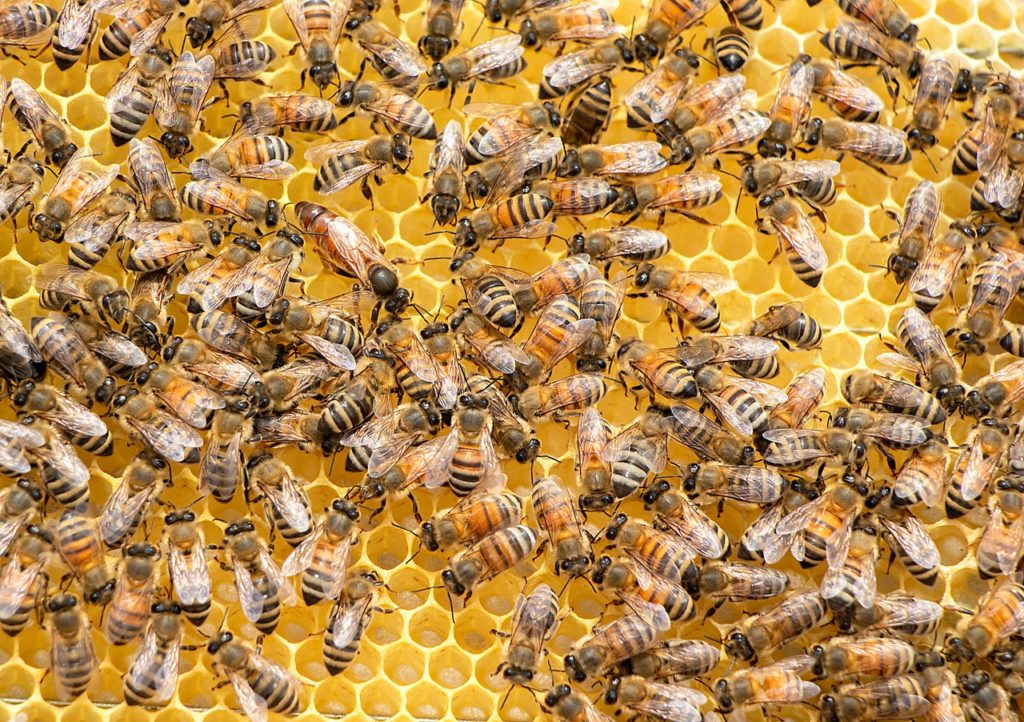
I learned this today. Bees make honey as a way to store food through the winter.
Flowers cannot move, so they need insects to help them reproduce. To pollinate another flower, the pollen from one flower has to reach another flower. The best way for flowers to do this is to have the pollen stick to the hairs on a visiting insect. When this insect travels to another flower, this pollen will be knocked off and the flower will be pollinated. In order to pollinate other flowers, flowers have evolved a way to get insects to visit them. They produce a sugary liquid called nectar.
Honey begins as this nectar. Nectar is mostly water with sucrose, glucose, and fructose. It also has vitamins, oils, and amino acids. The sweetness varies from plant to plant, but the sweetest nectars can have a 50% sugar concentration. The nectar has a scent that attracts the honeybees and they can also see the ultraviolet light that the nectar reflects.
Forager bees land on the flower and suck up the nectar with their long proboscis. The nectar goes straight into the first chamber of their stomach. This is called the proventriculus. They can carry up to 80 milligrams of nectar at a time. Once in the stomach chamber, enzymes start to break down the sucrose into simple fructose and glucose. Another enzyme raises the acidity level of the nectar, protecting it from bacteria.
Forager bees start flying when they are three weeks old and they live until they are seven weeks old. An average hive has up to 10,000 to 50,000 bees in it and about 30% of those are forager bees. They start out as nurse bees. They clean the wax cells for the queen’s eggs and they feed honey and pollen to the larvae. They look after the queen. When they are three weeks old, the gene expression in the brain of most of the nurse bees changes and they become forager bees.
The forager bee then flies back to the hive. If they found a flower with a lot of nectar, they will perform a dance to tell the other bees where it is. The dance communicates the distance, the direction, and the quantity of nectar available.
The forager bee then enters the hive and gives up its nectar. It regurgitates it into the mouth of a worker bee. While this is happening, the antennae of the forager bee and the worker bee are constantly touching. This is how they communicate. Once all of the nectar has been passed over, the forager bee will replenish its energy with a little honey, and then fly off to forage again. A forager bee will make about 12 trips a day, on average. Obviously, they will go out more often if the flowers are closer. They can fly as far as 5km away from the hive, but they have to use all of the nectar they harvest as energy, so it isn’t really worth it for them.
The worker bees start to pass the nectar amongst themselves, from mouth to mouth. Each time the nectar is passed, the water content is slightly reduced. They keep doing this until the water content of the nectar is 18%. The nectar is now honey. With its low water content and slightly high acidity, bacteria and mold can’t grow on it.
The worker bees push the honey into wax chambers to store it. They seal the entrance to the chamber with a liquid secretion from their abdomen. This hardens and becomes beeswax. It keeps the honey airtight and watertight. Honey stored in this way can last for a very long time.
The bees use the honey to feed themselves and feed larvae in the run up to the summer. Then they gather nectar and make honey like crazy all through the summer so that they have a large enough store of food to last through the winter. 12 bees can make about a teaspoon of honey in their lifetimes. So, when you drizzle honey on your toast for breakfast, you are eating the life work of about a hundred bees. Something to be grateful for.
So, nurse bees become forager bees when they are three weeks old. The forager bees fly out and harvest nectar from plants. They break it down in their stomach before passing it to worker bees. The worker bees then pass it from mouth to mouth to evaporate most of the water, making honey. They store the honey in wax cells as a food source for the winter. And this is what I learned today.
Photo by mostafa eissa from Pexels
Sources
https://en.wikipedia.org/wiki/Waggle_dance
https://journeynorth.org/tm/monarch/nectar.html
https://wonderopolis.org/wonder/how-do-bees-make-honey
https://www.sciencefocus.com/nature/how-do-bees-make-honey/
